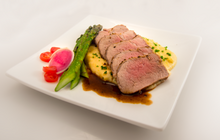| This article needs additional citations for verification. Please help improve this article by adding citations to reliable sources. Unsourced material may be challenged and removed. Find sources: "Pork tenderloin" – news · newspapers · books · scholar · JSTOR (May 2021) (Learn how and when to remove this message) |



Pork tenderloin, also called pork fillet, pork steak or Gentleman's Cut, is a long, thin cut of pork.
As with all (mammalian) quadrupeds, the tenderloin refers to the psoas major muscle along the central spine portion, ventral to the lumbar vertebrae, the most tender part of the animal, because those muscles are used for posture rather than locomotion.
Products and uses
In some countries, such as the United States and the Netherlands ('varkenshaas'), pork tenderloin can be bought as a processed product, already flavored with a marinade. A regional dish of the Midwestern United States is a pork tenderloin sandwich, also called a tenderloin – a very thinly sliced piece of pork, which is the larger, tougher loineye - or longissimus - muscle, which is battered or breaded, deep fried, and served on a small bun, often with garnishes such as mustard, pickle and onions. This sandwich is relatively common and popular in the U.S. Midwest, especially in the states of Iowa and Indiana. In the southern states, tenderloin is often prepared as a breakfast biscuit, typically with egg or cheese. It is quite common for pork tenderloin to be used as an alternative to beef tenderloin as it can be just as tender but costs significantly less.
In popular culture
Alton Brown's television show Good Eats includes an episode titled "Tender is the Pork" about pork tenderloin.
See also
References
- Anderson, M.; Fey, R. (2022). The Best Grilling Cookbook Ever Written By Two Idiots. Page Street Publishing. p. 165. ISBN 978-1-64567-607-2. Retrieved June 20, 2022.
- Campbell, G.; Ekman, M. (1992). Classic Irish Recipes. William G. Lockwood and Yvonne R. Lockwood Collection of National, Ethnic and Regional Foodways. Sterling Pub. p. 38. ISBN 978-0-8069-8444-5. Retrieved June 20, 2022.
- Danforth, A. (2014). Butchering Poultry, Rabbit, Lamb, Goat, and Pork: The Comprehensive Photographic Guide to Humane Slaughtering and Butchering. Storey Publishing, LLC. p. 62. ISBN 978-1-60342-931-3. Retrieved June 20, 2022.
- ^ Wolff, P. (2020). Fried Walleye and Cherry Pie: Midwestern Writers on Food. At Table Series. University of Nebraska Press. p. 67. ISBN 978-1-4962-0922-1. Retrieved June 20, 2022.
- Clampitt, C. (2018). Pigs, Pork, and Heartland Hogs: From Wild Boar to Baconfest. Rowman & Littlefield Studies in Food and Gastronomy. Rowman & Littlefield Publishers. p. 129. ISBN 978-1-5381-1075-1. Retrieved June 20, 2022.
- "Tender is the Pork". Food Network. May 30, 2015. Retrieved June 25, 2022.
